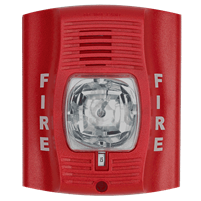OCCUPANT NOTIFICATION SYSTEMS
Visual Devices for the Fire Alarm System
People who are deaf or hard of hearing cannot hear alarms and voice announcements that warn of danger and the need to evacuate. Many codes require new buildings to have flashing strobe lights (visual devices) as part of the standard building alarm system, but because the requirements are not retroactive many buildings don’t have them. In addition, strobes are required only on fire alarm systems and simply warn that there may be a fire. Additional information that is provided over voice systems for a specific type of emergency such as a threatening weather event, or that directs people to use a specific exit, are unavailable to people who are deaf or hard of hearing.
It is extremely important for people who are deaf or hard of hearing to know what, if any, visual notification systems are in place. They also need to be aware of which emergencies will activate the visual notification system and which emergencies will not. Alternative methods of notification need to be put into the emergency evacuation plans for people who are deaf or hard of hearing so they can get all the information they need to evacuate in a timely manner.
Devices or Methods for Notification of Other Emergencies
The following is a partial list of emergencies that should be considered in the development of alternative warning systems:
-
Natural events
-
Storms (hurricanes, tornadoes, floods, snow, lightning, hail, etc.)
-
Earthquakes (Although a system would provide only a few seconds’ notice, it may lessen anxiety and prevent panic.)
-
-
Human-caused events (robbery, hostile acts, random violence, etc.)
Special Note 9
Scrolling reader boards are becoming more common and are being applied in creative ways. In emergency situations, they can flash to attract attention and provide information about the type of emergency or situation. Some major entertainment venues use this technology to provide those who are deaf or hard of hearing with “closed captioning” at every seat, for very little cost. A reversed scrolling reader board is mounted in the back of the room. Guests who are deaf or hard of hearing are provided with small teleprompter-type screens mounted on small stands. The guests place the stands directly in front of themselves and adjust the screens so they can see the reader board reflected off the screens. The screens are transparent, so they don’t block the view of guests behind the screen users.
If a person who is deaf or hard of hearing is likely to be in one location for a significant period of time, such as at a desk in an office, installation of a reader board in the work area might be considered to provide appropriate warning in an emergency.
Personal notification devices are also coming on the market. Such devices can be activated in a number of ways, including having a building’s alarm system relay information to the device. Information can be displayed in a variety of forms and outputs.
E-mail and TTY phone communications are other alternative methods of notification for people who are deaf or hard of hearing.
Another option is the use of televisions in public and working areas with the closed caption feature turned on. The U.S. Department of Agriculture offices in Washington D.C. use this technology.




User Comments/Questions
Add Comment/Question